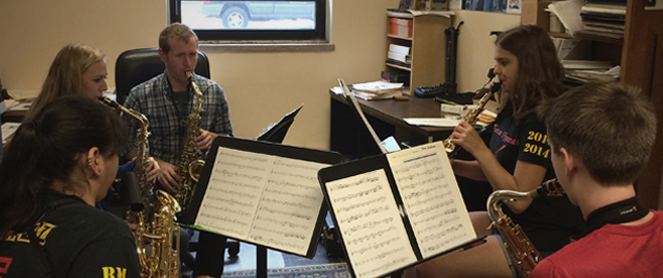
Today’s saxophonists are expected to perform many styles of music at a high level. Consequently it’s vital they know how to correctly formulate an embouchure that will allow them to do so. Most often, younger students are unaware that there is a difference in a classical and jazz embouchure. It’s not until they become undergraduate music majors that any real distinction is made.
Learning the difference earlier can give them greater success when moving between these styles and build a stronger foundation for sound production. Of course, there are other factors that help create the proper sound, such as mouthpieces and reeds, but the embouchure is the initial, most important step in the process.
Classical Embouchure
The classical saxophone embouchure was originally devised from attributes of the clarinet embouchure. These are very similar, with the exception of the angle at which the mouthpiece enters the mouth. Most sax teachers agree on the basics of forming the classical embouchure, but some details are up for debate.
In forming the embouchure, the bottom lip is pulled tightly across the bottom teeth, which allows the lip to create a cushion. The cushion is where the reed sits and should remain hard, or firm, as it is stretched across the bottom teeth. The firmness of the bottom lip is further reinforced by the chin being drawn downward, and remaining flat. This also allows the lower lip to be rolled out just enough so the reed vibrates properly. If the lower lip sits too far inside the mouth, it will excessively dampen the reed, causing it to not vibrate properly. Lastly, the top teeth sit firmly on top of the mouthpiece, while the jaw provides support for the lower lip. Some teachers, such as Joe Allard, suggest that the upper teeth and upper lip work in tandem to accept the force given from the bottom teeth and lip.
Approaches to the corners of the classical embouchure vary. Larry Teal and other teachers advocate applying equal pressure all around the mouthpiece, similar to a drawstring, in addition to bringing the corners towards the center, as if preparing to whistle. Allard, on the other hand, believes this dulls the sides of the reed, thus preventing overtones from being present in the sound. He proposes to use the bottom lip to apply pressure to the center part of the reed, allowing the sides to vibrate freely. Students seem to respond with greater success to the drawstring approach because they can visualize it easily, but it is important to be aware of both techniques.
Some teachers argue that the jaw should have some flexibility and movement while forming a classical embouchure, while others suggest it remain more stationary. When I teach the classical saxophone embouchure, I firmly suggest keeping the jaw stationary. A middle C should be played with the same pressure as a low C, and so on. I often see students attempting to “drop the jaw” as they descend into the lower register, or worse yet, they jut the jaw forward on the mouthpiece, exposing even more reed inside the mouth. With this large amount of reed vibrating inside the mouth, the sound becomes much less focused and more spread.
Classical embouchure example
Lastly, if a student is having trouble grasping the appropriate amount of mouthpiece to take in, have them take the neck off of their instrument and hold it up so they are looking directly at the reed. Then, rotate the neck to the left so they can observe the space between the reed and the mouthpiece. The point at which the mouthpiece and reed meet is a good approximation for how much mouthpiece they should take into their mouth.
Note where the reed meets the mouthpiece
Jazz Embouchure
The classical embouchure can act as a solid foundation for the saxophonist, but a distinctly different formation should be used when playing jazz. The first thing to change is the amount of pressure being exerted by the jaw. A jazz embouchure has significantly less jaw pressure than in a classical embouchure. I visualize a separation of the top and bottom teeth, allowing for the pressure to be supplied not by the jaw, but by the lower lip. With the jaw being “dropped,” or drawn downward toward the clavicle, the bottom lip is now responsible for the pressure on the reed, which will allow the reed to vibrate more freely.
Imagine fingers are teeth; classical separation on left, jazz on right
Because the jazz embouchure focuses on maximum reed vibration, the lower lip should be rolled outward, toward the saxophone, creating a soft, thick cushion that separates the teeth from the reed. This is done to expose more of the reed inside the mouth, resulting in a fuller, more vibrant sound.
However, the lowering of the jaw and the lip supplying a softer cushion means that the chin will inevitably bunch. This is characteristic of the jazz embouchure and directly opposes the flat chin mentioned above. The player can picture the muscles of the chin shifting upward and outward, while the teeth are separated and drawn downward. This will result in a bunched chin, rolled out lip, more reed exposed within the mouth, and the creation of a soft cushion supporting the reed.
Jazz embouchure example
The final point to be made is that the jaw is much more flexible when playing jazz. It frequently moves up and down when engaged. Because jazz requires less jaw pressure, it has the ability to move more freely. Typically, the jaw will apply less pressure on the reed when descending throughout the instrument and more pressure when playing higher. Additionally, it is also used as a means to make certain notes “stick out” of the texture. The accented notes will have more jaw pressure placed on them, whereas notes that are unaccented may utilize less pressure.
Here is a summary of the differences between the two embouchures: